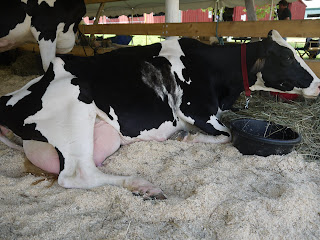If you measured summer by its fruits, this would be the season of the third berry. Blueberry time is here, but won't last much longer. Strawberries are long gone. (We had only a few plants growing near the house.) Our raspberries gave us several pints, but only a few berries remained as of last week. (Note to self: must remember to cut the stalks for a bigger harvest next year.) Our small vegetable garden is producing at a pretty rapid clip, the usual tomatoes, cucumbers, squash, eggplant. There's a pear tree growing wild at the end of our woods with plenty of pears, quite high up, and probably still unripe. Our apple trees aren't doing much in the way of production. Hmmm. Not enough cross-pollination? Or is this a bi-annual thing?
Among the uncultivated, it’s time now for Queen Anne’s Lace (Daucus carota, suggesting the carrot family) in bloom just about everywhere, blue wild chicory (Cichorium intybus), blooming nearly everywhere. But there’s an interloper, one I hadn’t heard of in Massachusetts – wild parsnip (Pastinaca sativa, another carrot family member; doesn’t that sound like something you’d like to pick?). If you brush up against this plant in sunlight, you will likely end up with a rash, blisters, and skin discoloration lasting for months. The effect is called phytophotodermatitus. Wild parsnip tends to grow along roadsides or in untended fields, and has now mostly turned to seed. The plant has been known around here for over a hundred years but is only recently proliferating. No one seems to know why.
**
Another sign of late summer: the annual Addison County Field Days ended last weekend. If you didn’t already know, you would learn that cows are rated for the beauty of their udders and the manner in which these are supported by the rest of their huge bodies. Or you could discover truly beautiful chickens.
You might find out how much agriculture depends upon humongous machinery. The top of my head only made it to the top of the tires in this example. It makes you tremble for the creatures that nest or nestle in the fields among the tall grasses and corn.
You might find out how to hand-scythe, or how much weight Percherons or Belgians can pull, or how they were once employed at one end of a Rube Goldberg-like contraption for sawing wood. Having seen all that and more, it would be time for maple creemies and a couple of rounds of the Demolition Derby. If you were Hans, Olin, Carly, Audrey, or Ben there would be time at the fair for hours of whirling, spinning, and zooming.






No comments:
Post a Comment